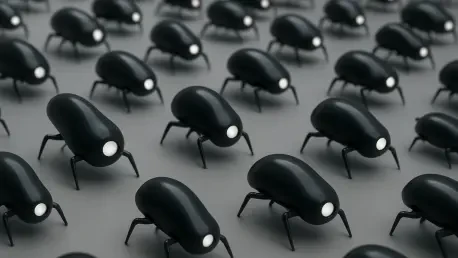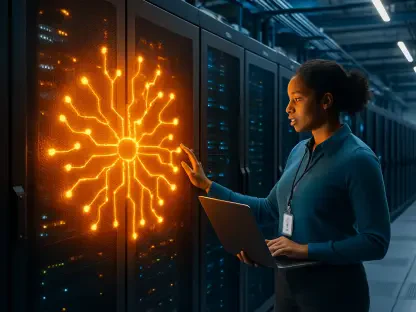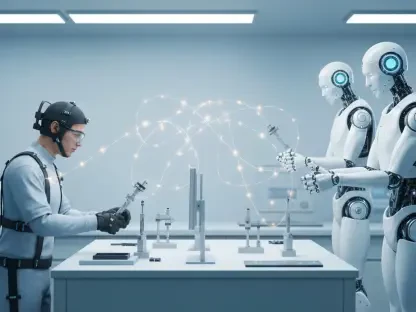Swarm intelligence in artificial intelligence (AI) represents one of the most captivating frontiers of modern technology, drawing inspiration from the mesmerizing coordination seen in nature’s collectives, such as birds flocking effortlessly across the sky, fish schooling in synchronized harmony, or bees swarming with purposeful unity. These natural systems achieve extraordinary feats of collaboration without a central authority, solving complex challenges like finding food or evading threats through simple, decentralized interactions. In the technological sphere, mimicking such behavior holds immense promise for transforming critical applications, from coordinating drones in search-and-rescue operations to monitoring wildfires with robotic precision. Yet, the path to replicating nature’s agility and autonomy in artificial swarms has been fraught with obstacles, as synthetic systems often struggle with scalability and adaptability. A groundbreaking study now offers a novel solution, introducing a geometric property called “curvity” that could redefine how swarm intelligence is harnessed in AI, setting the stage for more efficient and responsive robotic networks.
Drawing Lessons from Nature’s Playbook
Nature provides an unparalleled blueprint for coordination, where decentralized systems thrive without the need for a guiding leader. In bird flocks, each individual adjusts its trajectory based on the subtle movements of nearby companions, creating a fluid, dynamic pattern that optimizes travel and resource discovery. Similarly, fish align their motions to maintain tight schools that confound predators, while bees use intricate communication to swarm effectively during migration or hive-building. For AI researchers, the challenge lies in distilling these emergent behaviors into synthetic frameworks that can operate without centralized control. As noted by experts at Radboud University, crafting such decentralized mechanisms for robotic swarms remains a formidable task, largely because artificial systems lack the inherent flexibility and scalability that natural collectives demonstrate effortlessly. This gap has long hindered the practical deployment of swarm intelligence in real-world scenarios, pushing scientists to seek innovative approaches.
Beyond the conceptual hurdles, the intricacies of natural swarms reveal a deeper layer of complexity that artificial systems must address. While a bird or fish reacts instinctively to environmental cues and neighbor interactions, robotic swarms often rely on pre-programmed algorithms or external directives that limit their responsiveness. This discrepancy becomes especially pronounced in dynamic, unpredictable settings where adaptability is paramount. The aspiration to mirror nature’s leaderless harmony drives ongoing research, with the ultimate goal of creating robotic collectives that can self-organize and tackle tasks as seamlessly as their biological counterparts. Inspiration from these organic systems underscores the potential for AI to revolutionize fields like disaster response or environmental monitoring, provided the barrier of autonomous coordination can be overcome. The quest for such a breakthrough has led to a pivotal discovery that shifts the focus from software complexity to tangible, design-based solutions rooted in geometry.
Unveiling Curvity as a Game-Changer
A transformative concept known as “curvity” emerges as a cornerstone in the latest advancements in swarm intelligence, offering a fresh lens through which to view robotic coordination. Described in a seminal paper published in the Proceedings of the National Academy of Sciences, curvity functions much like positive and negative charges in physics, dictating whether robots within a swarm attract to form tight clusters or repel to produce flowing, flocking movements. Researchers from New York University (NYU) elaborate that this property is intrinsically linked to the curvature of a robot’s path or structural design, providing a direct mechanism to influence collective behavior. By embedding curvity into the physical makeup of robots, the daunting challenge of swarm control transitions from a software riddle to a materials science puzzle, making it far more approachable. This geometric principle marks a significant departure from traditional methods, promising a streamlined path to achieving nature-like coordination in artificial systems.
The elegance of curvity lies in its ability to simplify what was once an intricate problem, reducing the reliance on complex coding or external oversight. Experimental findings from the international research team, which includes experts from Radboud University in the Netherlands, demonstrate that adjusting the curvature in a robot’s design can predictably alter swarm dynamics, whether the goal is to create a stationary cluster for data collection or a mobile flock for area coverage. This approach proves effective even when scaling up to thousands of units, mirroring the effortless synchronization seen in natural swarms. Unlike earlier strategies that bogged down with computational overhead, curvity offers a hands-on, mechanics-driven solution that aligns with the physical realities of robotic hardware. Such a shift not only enhances feasibility but also broadens the scope of what swarm intelligence can achieve across diverse technological landscapes, setting a new benchmark for innovation in AI.
Bridging Theory with Practical Impact
The practical ramifications of the curvity framework extend far beyond academic curiosity, opening up a wealth of possibilities for real-world applications. Envision industrial robots in sprawling warehouses, collaborating seamlessly to optimize logistics, or fleets of delivery drones navigating urban airspace with precision to avoid collisions and ensure timely drop-offs. At a smaller scale, microscopic robots could revolutionize healthcare by targeting drug delivery at the cellular level, enhancing treatments with unparalleled accuracy. The design rules derived from curvity provide a concrete foundation for engineering such systems, making swarm intelligence not just a theoretical ideal but a tangible tool for solving pressing challenges. From bolstering disaster response with coordinated drone surveys to aiding environmental efforts through wildfire tracking, the versatility of this approach underscores its potential to reshape multiple industries with efficient, autonomous solutions.
Moreover, the accessibility of curvity as a control mechanism amplifies its transformative impact, as it sidesteps the need for sophisticated software or constant human intervention. By focusing on physical design, the framework empowers engineers to craft swarms that inherently embody desired behaviors, whether clustering for strength or dispersing for coverage. This shift in perspective, championed by the collaborative efforts of NYU and Radboud University scientists, addresses longstanding scalability issues that have plagued earlier swarm technologies. The ability to apply these principles across varying robot sizes and functions—from large industrial machines to tiny medical devices—further highlights the universal appeal of the discovery. As industries increasingly turn to automation for efficiency, the curvity-based approach offers a timely and adaptable solution, paving the way for robotic systems that can truly emulate the collaborative brilliance of nature’s swarms in practical, impactful ways.
Forging a Path through Multidisciplinary Innovation
The development of curvity as a guiding principle for swarm intelligence reflects the power of interdisciplinary synergy, uniting insights from physics, materials science, and robotics into a cohesive breakthrough. Perspectives from the research team illustrate the breadth of expertise fueling this advancement, with focuses ranging from scalability considerations to the theoretical underpinnings of curvature-driven behavior. This collaborative spirit, evident in the combined efforts of institutions like NYU and Radboud University, showcases how diverse viewpoints converge to tackle complex AI challenges. By grounding swarm control in a geometric property, the framework transcends traditional boundaries, offering a universal language for designing robotic collectives that operate with nature-like efficiency. Such integration of fields not only enriches the scientific discourse but also accelerates the translation of abstract concepts into actionable technologies.
Equally compelling is the forward-looking nature of this multidisciplinary effort, which sets a precedent for future explorations in bio-inspired AI. The emphasis on mechanical simplicity over computational intricacy invites broader participation from engineers and designers who may not specialize in software but can contribute through hardware innovation. This democratization of swarm technology could spur rapid advancements, as more minds engage with the accessible principles of curvity to refine and expand its applications. The collaborative model behind this research also serves as a reminder of the value of cross-border partnerships in addressing global technological needs, from enhancing emergency response capabilities to improving medical interventions. As a result, this breakthrough stands as a milestone in redefining how swarm intelligence is conceptualized and implemented, promising a future where robotic coordination mirrors the seamless elegance of natural systems.
Reflecting on a Pioneering Milestone
Looking back, the introduction of curvity as a mechanism for controlling swarm intelligence marked a defining moment in the evolution of AI and robotics. This geometric innovation, meticulously detailed in a landmark study, tackled the persistent challenge of decentralized coordination by embedding behavioral rules directly into the physical design of robots. Through rigorous experimentation, the research team demonstrated how curvature influenced swarm dynamics, enabling transitions between clustering and flocking with remarkable precision. The collaborative insights from international experts provided a robust foundation for this achievement, blending theoretical rigor with practical focus to address real-world needs. This milestone not only bridged the gap between natural inspiration and synthetic application but also laid the groundwork for future advancements in autonomous systems, reflecting a profound shift in how technology could emulate life’s most intricate patterns.
As a next step, attention turned toward refining and expanding the curvity framework to meet diverse operational demands. Efforts focused on testing its adaptability across varied environments, from urban landscapes to microscopic realms, ensuring that robotic swarms could perform reliably under any condition. Additionally, fostering partnerships between academia and industry emerged as a priority to accelerate the integration of this technology into everyday solutions, whether for enhancing disaster mitigation or revolutionizing healthcare delivery. Encouraging further research into complementary design principles also promised to enrich the framework, potentially uncovering new geometric properties that could enhance swarm autonomy. By building on the foundation established through this pioneering work, the field stood poised to unlock even greater possibilities, driving innovation toward a future where artificial swarms operated with the same instinctive brilliance as their natural counterparts.









